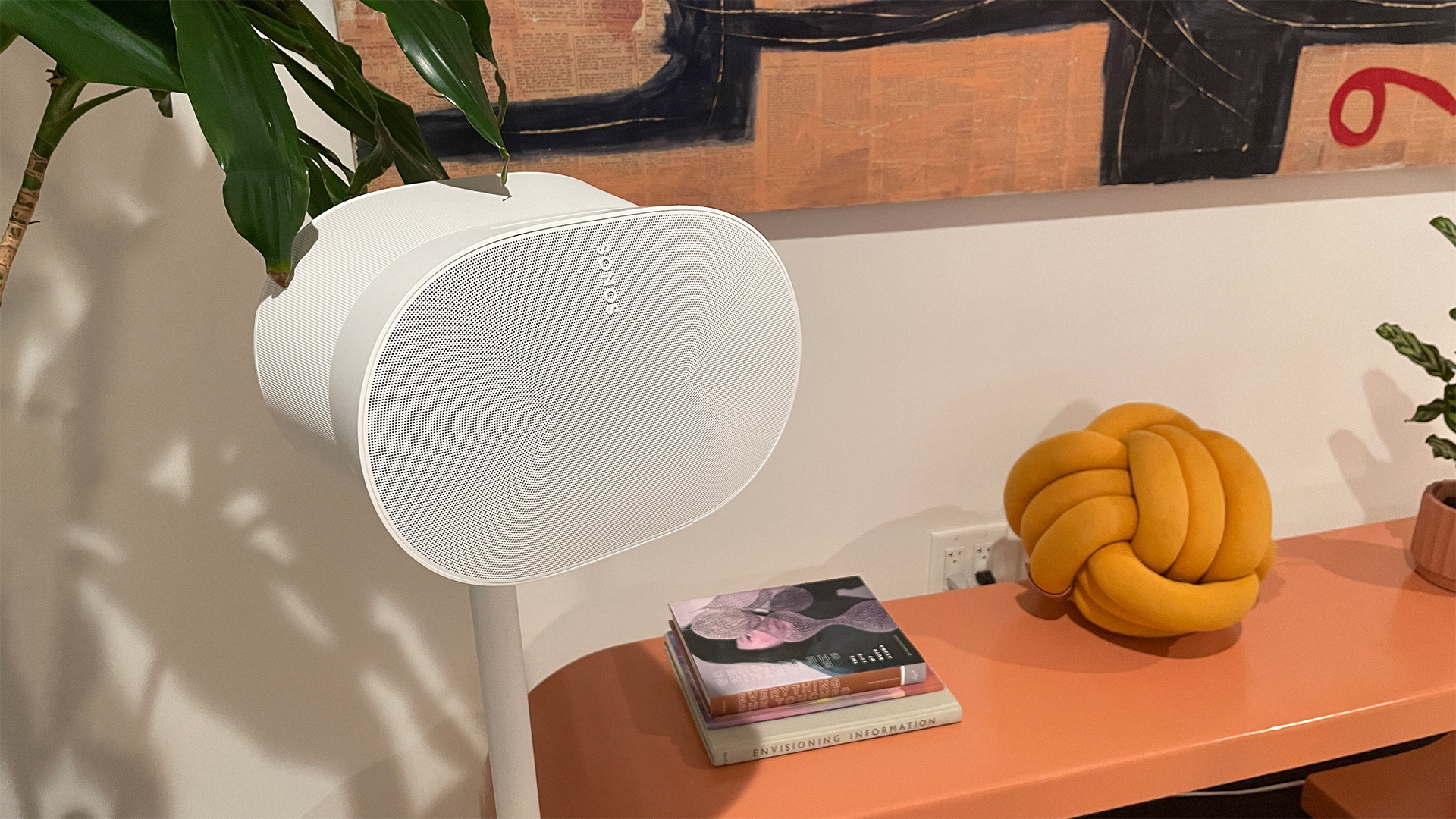
"The goal with Era 300 was really to create the best standalone spatial audio experience of any single speaker." As far as intentions go, it’s a bold statement from Sonos.
Sonos's Era 300 is a wireless smart speaker that comes packing all the goodness and seamlessness of a Sonos system, with a key stand-out feature that Sonos believes is the next generation of sound: spatial audio.
Spatial audio has been in the spotlight in recent years, featuring in Dolby Atmos-soundtracked movies, TV shows and now music. Spearheaded by Apple, ‘spatial audio’ has turned into a catch-all term that covers any music that uses the Dolby Atmos format to create multiple channels of audio (beyond the standard two) to deliver a greater sense of immersion. For music, which has been in good ol’ stereo for many decades, that’s quite a big change.
Apple led the charge this year with its spatial audio-toting HomePod 2 smart speaker, which impressed us with its musical talents across the board. Will the bigger, more expensive Sonos Era 300 beat Apple at its own game? And more importantly, will the Era 300 deliver an enjoyable sonic experience beyond just spatial audio?
Price
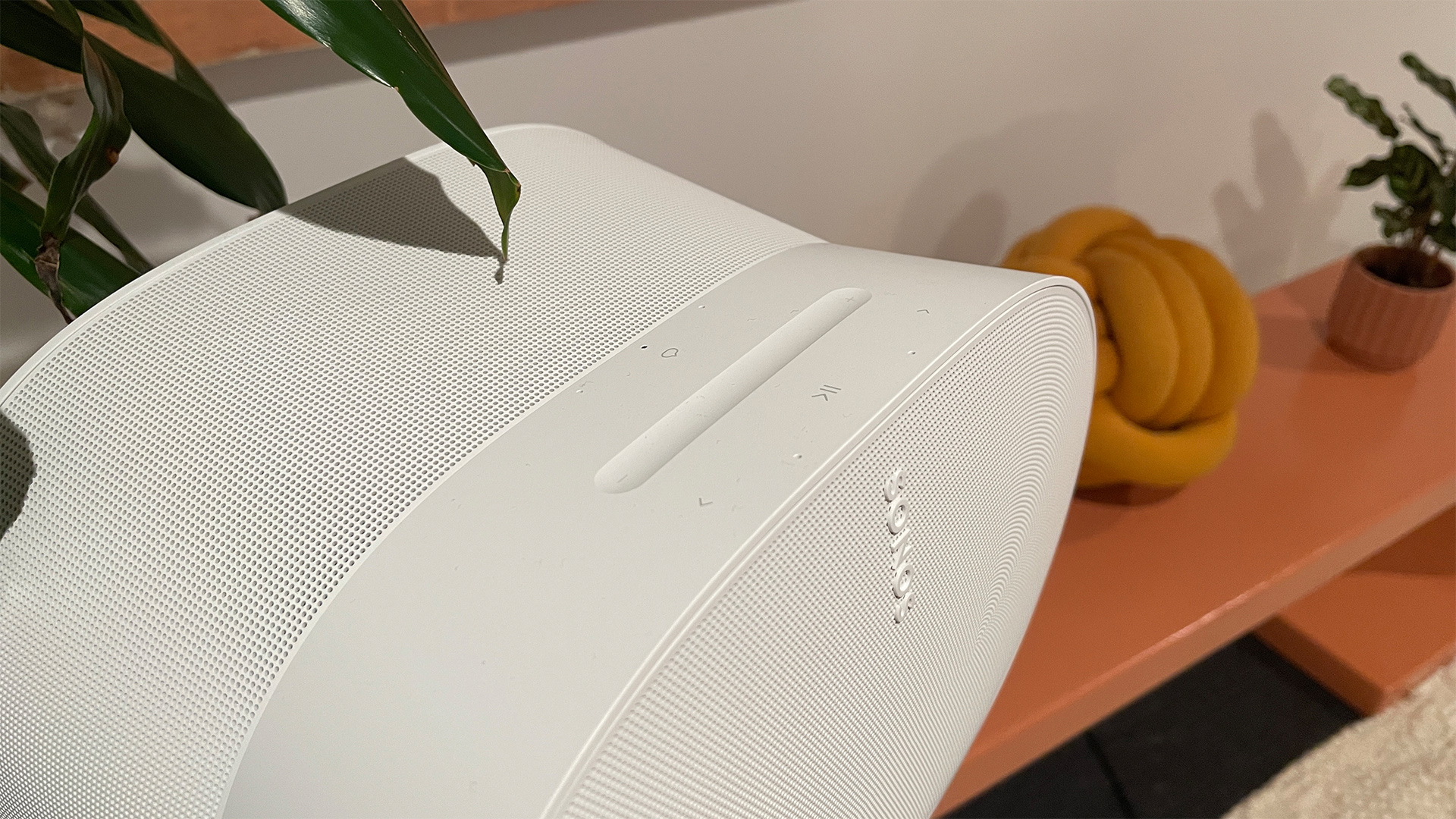
Sonos has priced the Era 300 at the premium end of the smart speaker market, clocking in at £449 / $449 / AU$749. That's quite a hefty sum to pay – in comparison, the closest rival Apple HomePod 2 costs £299 / $299 / AU$479.
It's still £50 / $100 shy of the most expensive wireless speaker that Sonos makes, which is the Sonos Five at £499 / $549 / AU$700. The big difference between the two is that the Five delivers stereo music; Sonos Era 300 ups the ante with an all-new design and spatial audio output.
Build & design
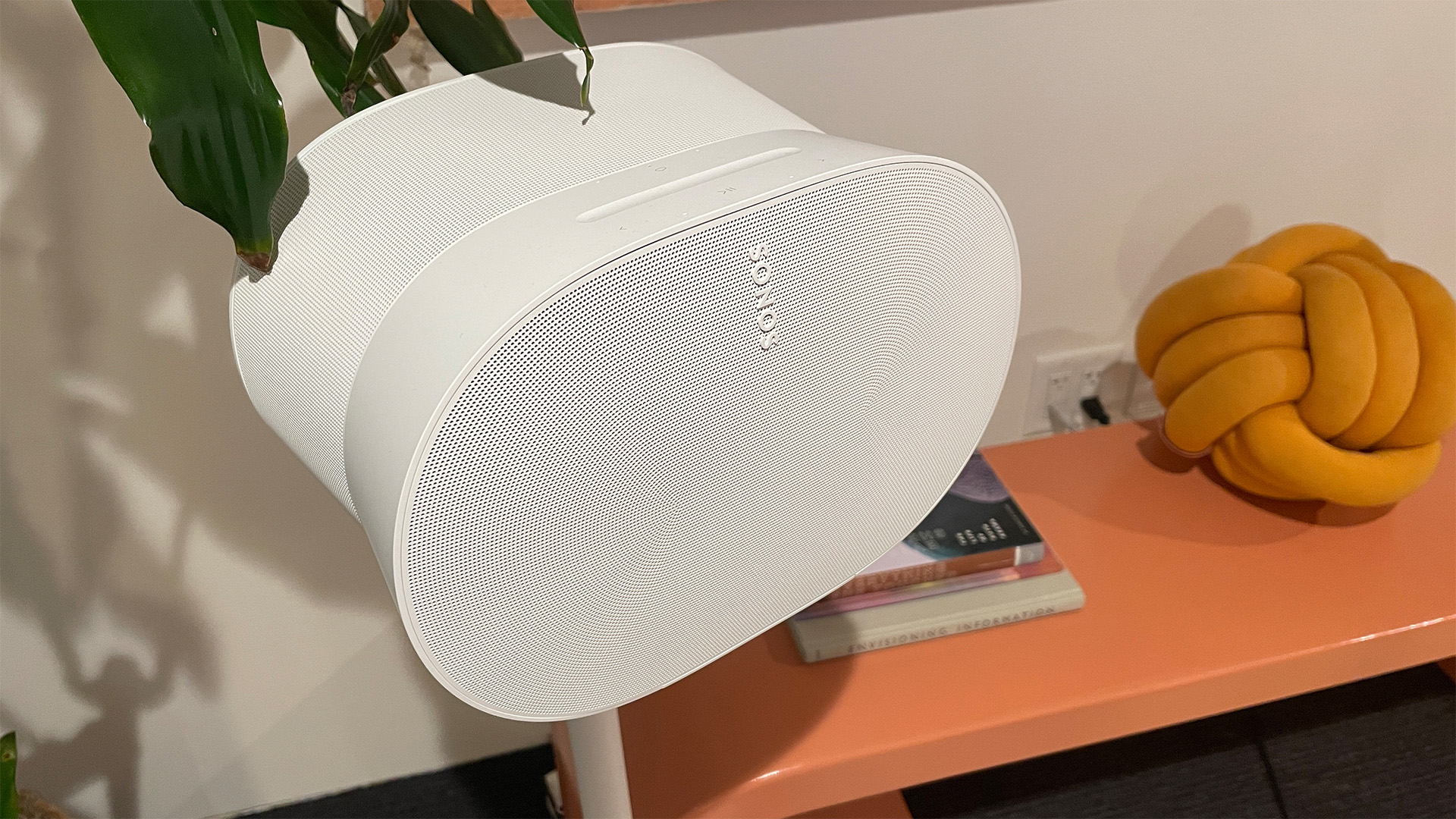
There’s no denying the Era 300 has an unusual shape – a “cinched hourglass” design is what Sonos calls it. It’s a bit bulky, yes, and it doesn’t quite blend into the environment in the way its other speakers do, but we feel Sonos wants to stand out and attract attention with this speaker. With the 300 placed in a room, we found ourselves soon getting used to the style and just listening to the music it’s delivering.
Like it or loathe it, it’s a design born out of necessity. With spatial audio playback being the Era 300’s focal point, this means a carefully considered but unusual arrangement of drivers and amplification that can fire out sound in all directions to deliver that 'immersive' audio experience – while still keeping a familial look that fits into Sonos's family of speakers.
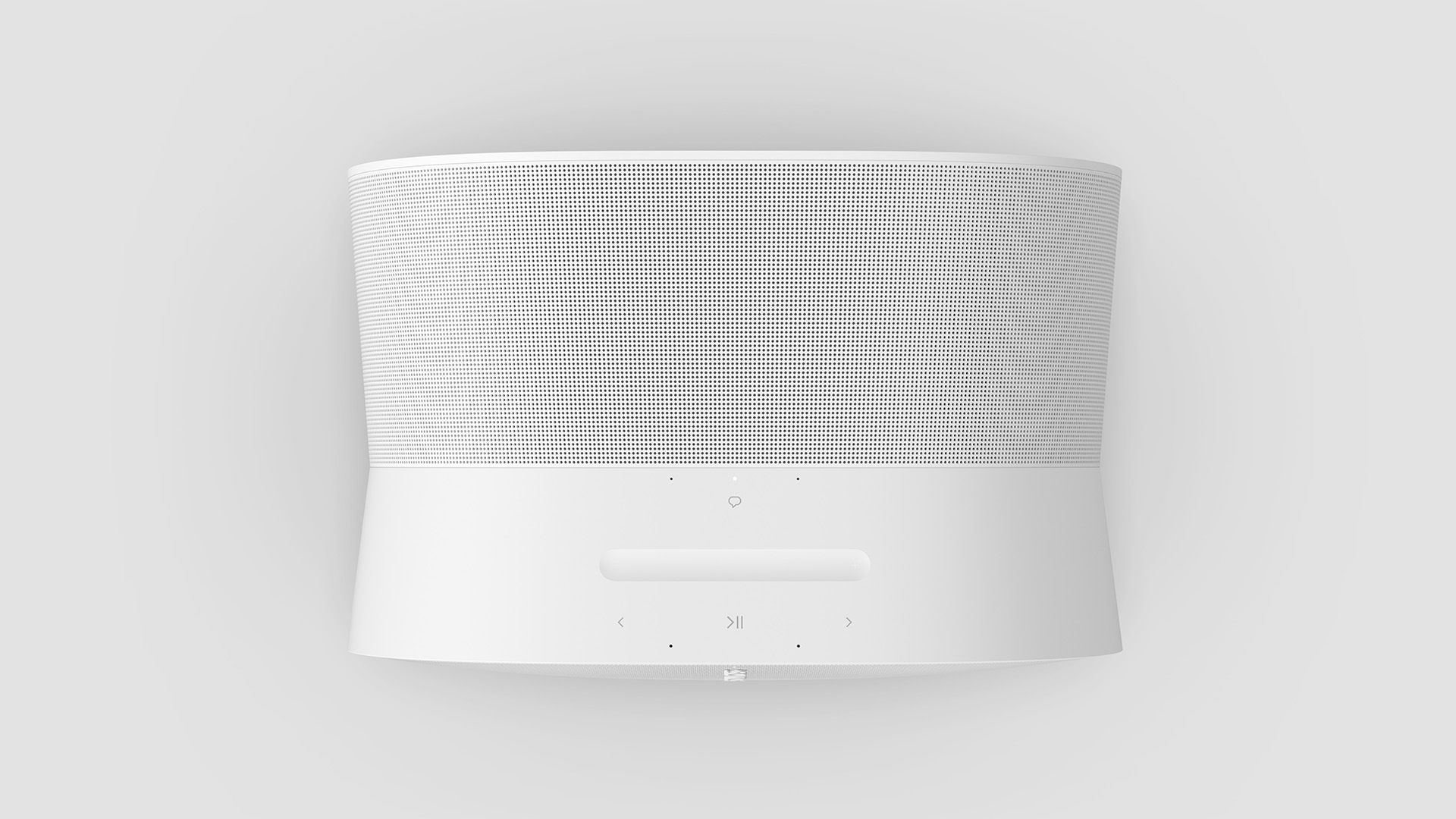
Bluetooth 5.0 (SBC, AAC)
Streaming AirPlay 2, wi-fi 6
Battery life N/A (mains-powered)
Features Spatial audio with Dolby Atmos, stereo pairing, Sonos voice control, Alexa voice control, Trueplay tuning, adjustable EQ
Connections USB-C line-in (separate adapters required)
App? Yes
Dimensions (hwd) 16 x 26 x 18.5cm
Weight 4.47kg
Finishes x2 (matte black, matte white)
Inside the Era 300 are six drivers: four tweeters (one forward-firing, two side-firing, one upward-firing) and two woofers (angled left and right for stereo playback). These are complemented by custom waveguides that help direct sound out forwards, upwards, left and right to surround you with music. Each of the six drivers is also powered by its own class D amplifier.
That upward-firing tweeter is Dolby Atmos-specified, too, loaded into a directional horn and designed to reflect sound off the ceiling when playing Dolby Atmos music. When setting up the Era 300, Sonos suggests you leave at least 8 inches (20cm) from the wall, and you can adjust the level of the height channel in the app’s settings, too.
The upward-firing driver needing space to fire out sound through the top of the speaker means that Sonos has had to move the control panel a touch forward as opposed to it being in the middle as originally intended, and also move the cinch point – hence the quirky design.
Visually, the Era 300 has a clean profile and we can’t argue with the build quality, which is made to Sonos’s typically high standards and is a breeze to use. Apart from the Sonos logo on the grille, there aren't any buttons or displays (bar a single LED that you can turn off) on the front. And the finish – in matte black or matte white – fits in neatly with the rest of the brand's products, especially its more affordable stablemate, the Era 100.
On top, you’ll find a refreshed interface, with a volume slider dented into the speaker to help users glide their finger across to change the volume. It’s satisfyingly responsive and beeps feedback as you change the volume (which is rather friendly), while the touch capacitive buttons for playback and voice control are as responsive as ever.
Features
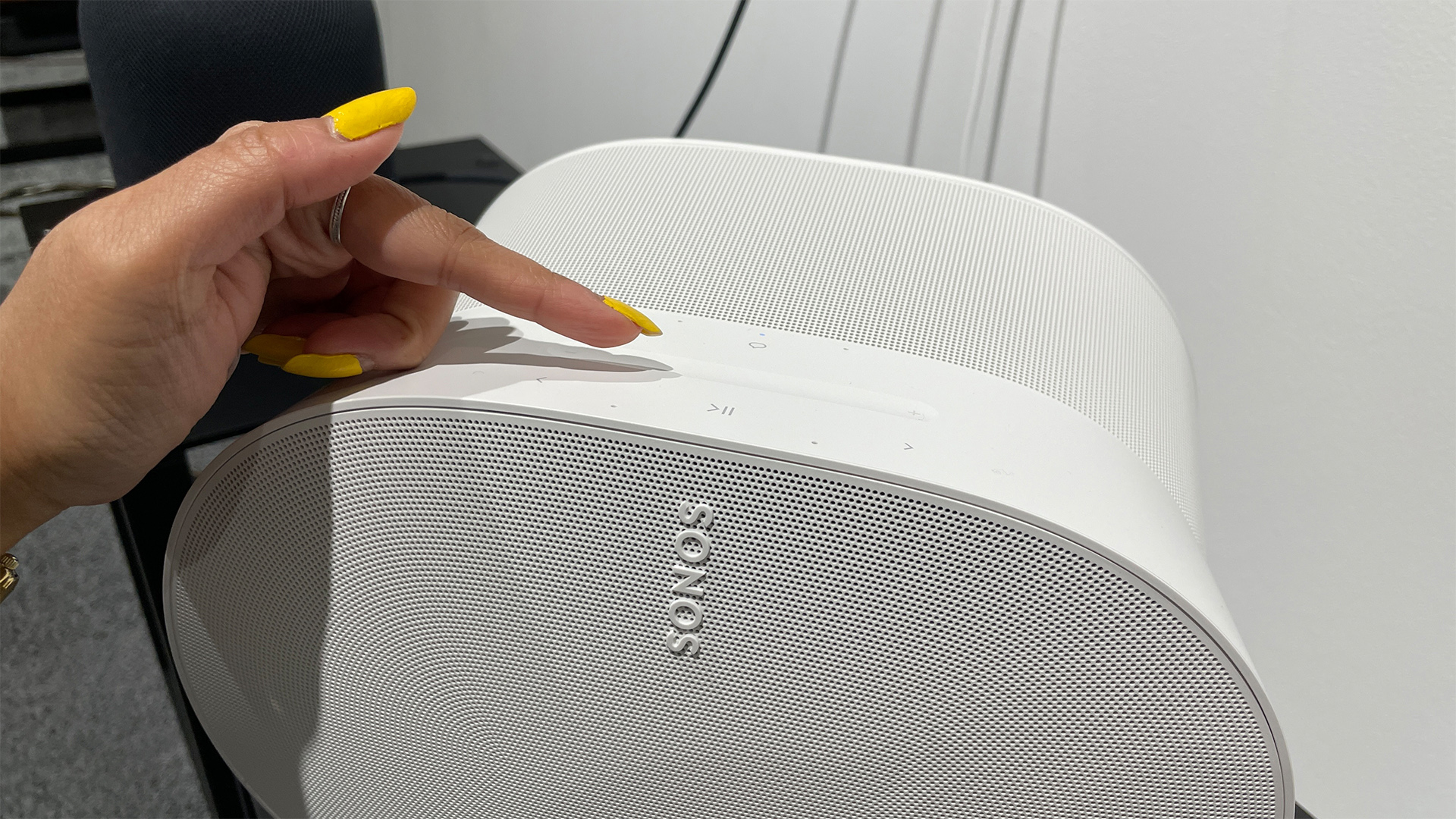
The headline feature here is the support for spatial audio with Dolby Atmos tracks, but there’s the small matter of exactly where you can play Dolby Atmos-powered spatial audio tracks from on the Era 300. Sonos has always erred on the side of being platform-agnostic – a fairly open approach meaning that regardless of what device or streaming service you use, you can play the music you want through a Sonos speaker. That’s been a key pillar of its popularity throughout the years.
There’s a small caveat with the Era 300’s spatial audio playback. At launch, Dolby Atmos Music from Amazon Music Unlimited is supported, while spatial audio from Apple Music will arrive on 28th March – when the Era 300 goes on sale. There’s no support for Tidal’s catalogue of Dolby Atmos/spatial audio tracks in sight, however, which is a shame.
Of course, it’s worth noting that Apple’s HomePod 2 only supports spatial audio through Apple Music, and doesn’t even support other streaming services through its Siri smart control. Sonos still gets the upper hand for wider compatibility, in comparison.
Apart from spatial audio, the biggest news is that the Sonos Era 300 can play music both over wi-fi (wi-fi 6 is supported) and Bluetooth. It's the first time Bluetooth has been included in Sonos's mains-powered speakers, having previously featured only on its portable Roam and Move models. Era 300 sports the Bluetooth 5.0 standard, with the basic SBC and AAC codecs on board. Bluetooth pairing is incredibly quick – instantaneous when you press the pairing button. It’s a swifter process than we’ve seen in any other Bluetooth speaker, and have to applaud Sonos for how seamless the connection with our iPhone is.
Also new is a USB-C port for wired connection to sources such as turntables. You will need a specific Line-In Adapter if you do want to use this connection though, and our main complaint is that this isn’t included in the box. You’ll have to pay £19 / $19 to buy the adapter through Sonos, which feels rather dear on top of the Era 300’s asking price.
AirPlay 2 streaming returns, along with 24-bit/48kHz hi-res music support from Qobuz and Amazon Music services. Voice control is also supported – through Alexa for all your smart home needs, or through Sonos’s own voice control that deals with music playback only. The latter is available in English and French only for now, but we found it responded well to our simple commands and the mic picked up our voice over the loud music being played. There’s now a physical switch to turn the speaker’s mic off entirely for full privacy, and the Bluetooth pairing button is also neatly hidden away at the rear.
There’s no Google Assistant, however. A change in Google’s technical requirements for third-party devices meant that Sonos hasn’t been able to include it in the Era 300, but we hope the two companies are able to work it out in due course.
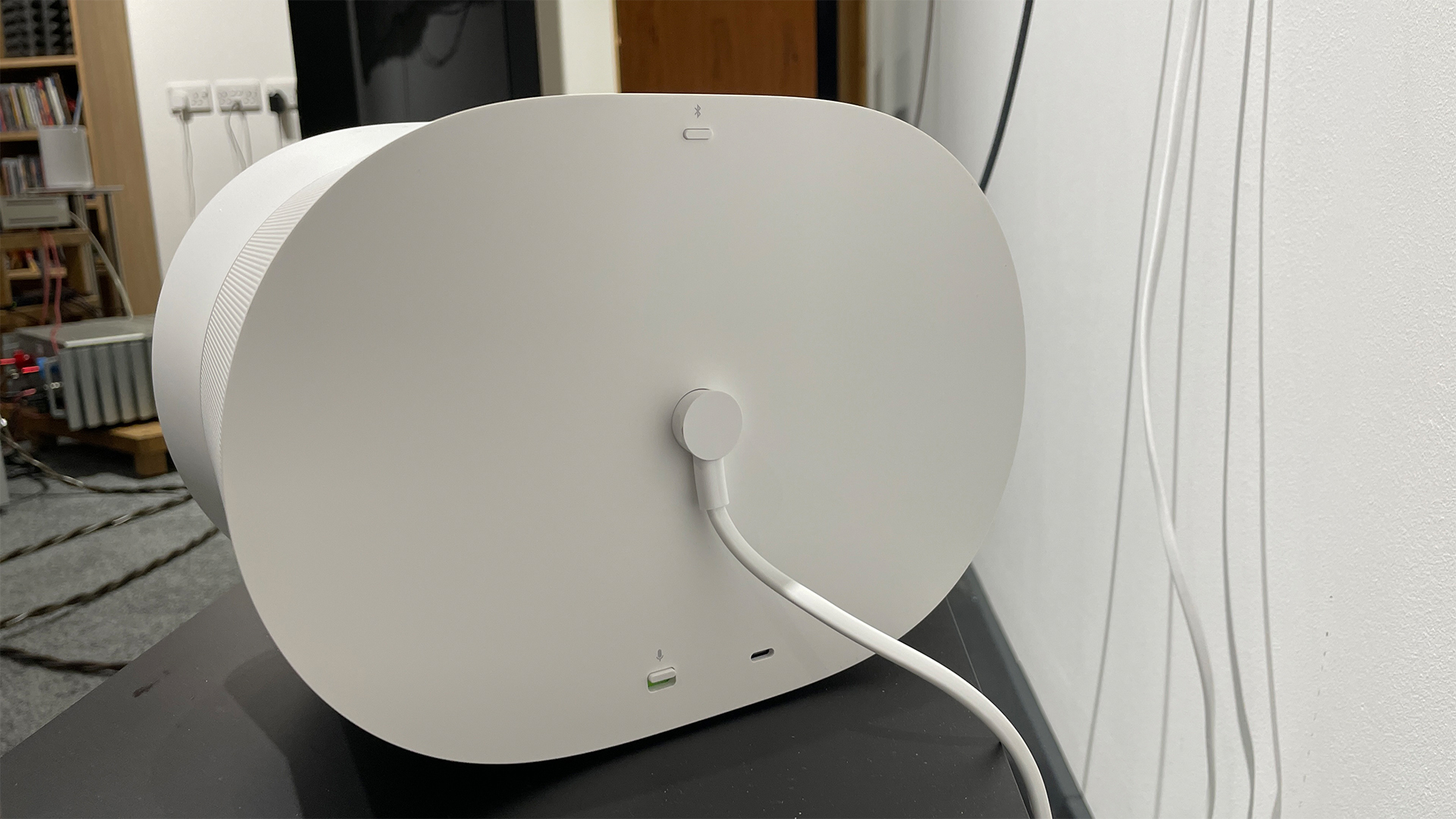
Playback from a huge number of streaming services, multi-room and stereo-pair grouping and more can be controlled through the excellent Sonos app, which we've always found to be well-featured and seamless to use. The ability to control all your music from one intuitive place is a neat solution, especially if you play music from multiple streaming services and internet radio.
You can tweak the speaker’s EQ settings for treble and bass more finely, and initiate Sonos’s Trueplay room calibration tuning. Now available for both iOS and Android, Trueplay optimises the Era 300’s sound to suit the room it’s in. We find that it makes the Era 300 sound clearer, more focused and less boomy in the bass, and we’d recommend taking advantage of Trueplay wherever you place the Era speaker in your home.
There’s also big news for AV fans: the Sonos Era 300 can be used as Dolby Atmos surround speakers, delivering multi-channel rears for the first time. These can be used in conjunction with the Sonos Arc and Beam Gen 2 soundbars and Sub to create a maximum 7.1.4 Dolby Atmos home theatre experience. We only have one review sample of the Era 300 for our testing, but the full Atmos movie experience is something we’re keen to try out in the future.
- Apple spatial audio: what is it? How do you get it?
- Dolby Atmos Music: everything you need to know about the spatial audio tech
Sound
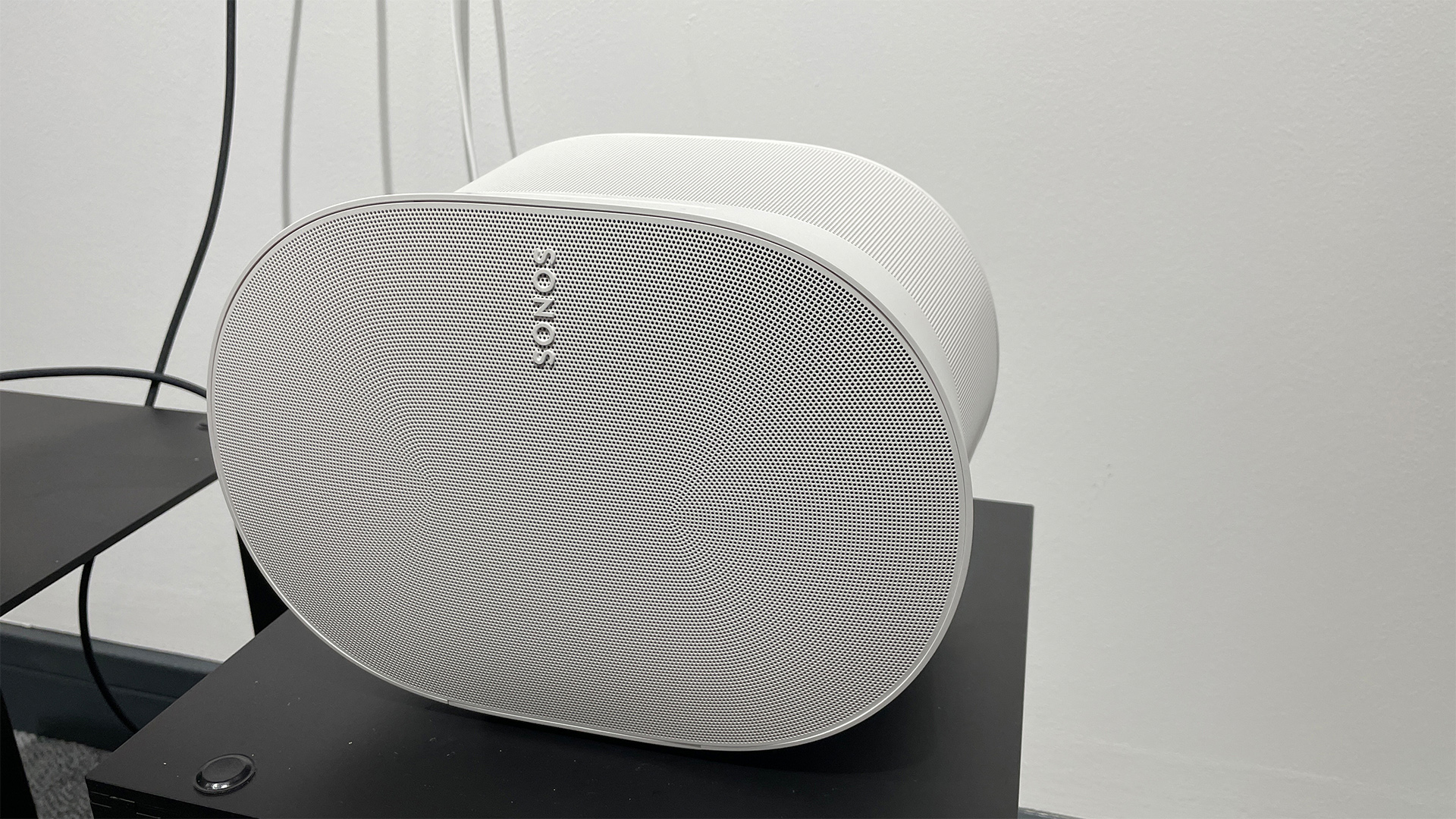
The majority of our Era 300 listening was done with Apple Music and Tidal for stereo music and Amazon Music Unlimited for spatial audio. We’ll update this review as soon as we’ve heard Apple Music’s spatial audio tracks on the Era 300 after support goes live on the 28th.
The first impression we get with the Era 300 is of scale. The spread of sound is immense from one single wireless speaker box. It projects sound further into the room and overhead more confidently than any other similar wireless speaker we’ve heard.
What’s just as impressive is how solid and cohesive it all sounds. Regardless of whether you’re listening to plain ol’ stereo or spatial audio tracks, the rich tapestry of instruments and vocals all feel apiece. There’s solidity, ample detail and fluid dynamics to each song, whether you’re listening to an ’80s rock anthem or a piano-led classical piece. Songs are thrown out into the room with the kind of scale and power we’d normally hear from much bigger speakers.
Sonos never shares power ratings, but there’s no denying the huge reserves of power brimming underneath the hood. Not just because the music’s rhythm is grippy, with ample grunt and impact to the low end; but also because of how easy it all sounds.
Where you can hear the smaller Era 100 speaker straining against its physical limitations at times, the Era 300 has no such restraints. The meaty, taut, propulsive bassline in Rage Against The Machine’s Bullet In The Head is gorgeously textured and effortlessly delivered. The crunchy guitars and spitting vocals are just as impactful; there’s punch and muscle alongside subtle but powerful dynamic shifts that keeps everything flowing.
Taylor Swift’s vocals in Anti-Hero flourish in the wonderfully spacious soundfield, with her voice sounding crystal clear and no bright or thin edges to be heard.
With spatial audio with Dolby Atmos tracks, sound is flung far from the Era 300’s box. The ominous choral intro to Sam Smith and Kim Petras’ Unholy is delivered as a wall of sound that completely fills the room and envelops you. The sound goes far beyond the confines of the speaker and the spread of sound is so convincing that it’s hard to actually pinpoint where exactly the sound is coming from. The ‘spatial audio’ effect doesn’t feel separate from the original musical intent; it simply sounds more immersive – something we’ve not encountered before with so much enthusiasm. It’s worth noting that spatial audio tracks can only be played over wi-fi, not Bluetooth, on the Era 300.
In the app’s settings, you can adjust the height channel’s level to suit how loud or intense you want the effect to be. We left it at zero after some experimentation, as it sounded the most balanced with the rest of the sound.
We continue listening to tracks we know and love in spatial audio (Rhiannon by Fleetwood Mac, No Diggity by Blackstreet, Come Together by The Beatles) and it’s the same story: it all sounds detailed, engaging and accomplished. And it’s fun, too.
While there’s a significant price difference between the Era 300 and the HomePod 2, a comparison between the two spatial audio speakers is necessary. The HomePod still retains its rich texture and wonderful sense of musicality, but we’re struck by how small-scaled it sounds next to the Era 300. In general and also in particular with spatial audio tracks, the Era 300 outdoes the HomePod 2 in every way. There’s more power and punch, more convincing shifts in dynamics and emotions, and there is more detail and subtlety around each note. The Era 300 relays the rich harmonies and decaying reverberations around the piano notes in Light Of The Seven from the Game Of Thrones soundtrack, while James Blake’s Limit To Your Love is breathtaking with its cavernous scale and gut-punch impact of the plunging, deep bassline.
This is a very mature, very assured performance from Sonos.
Verdict
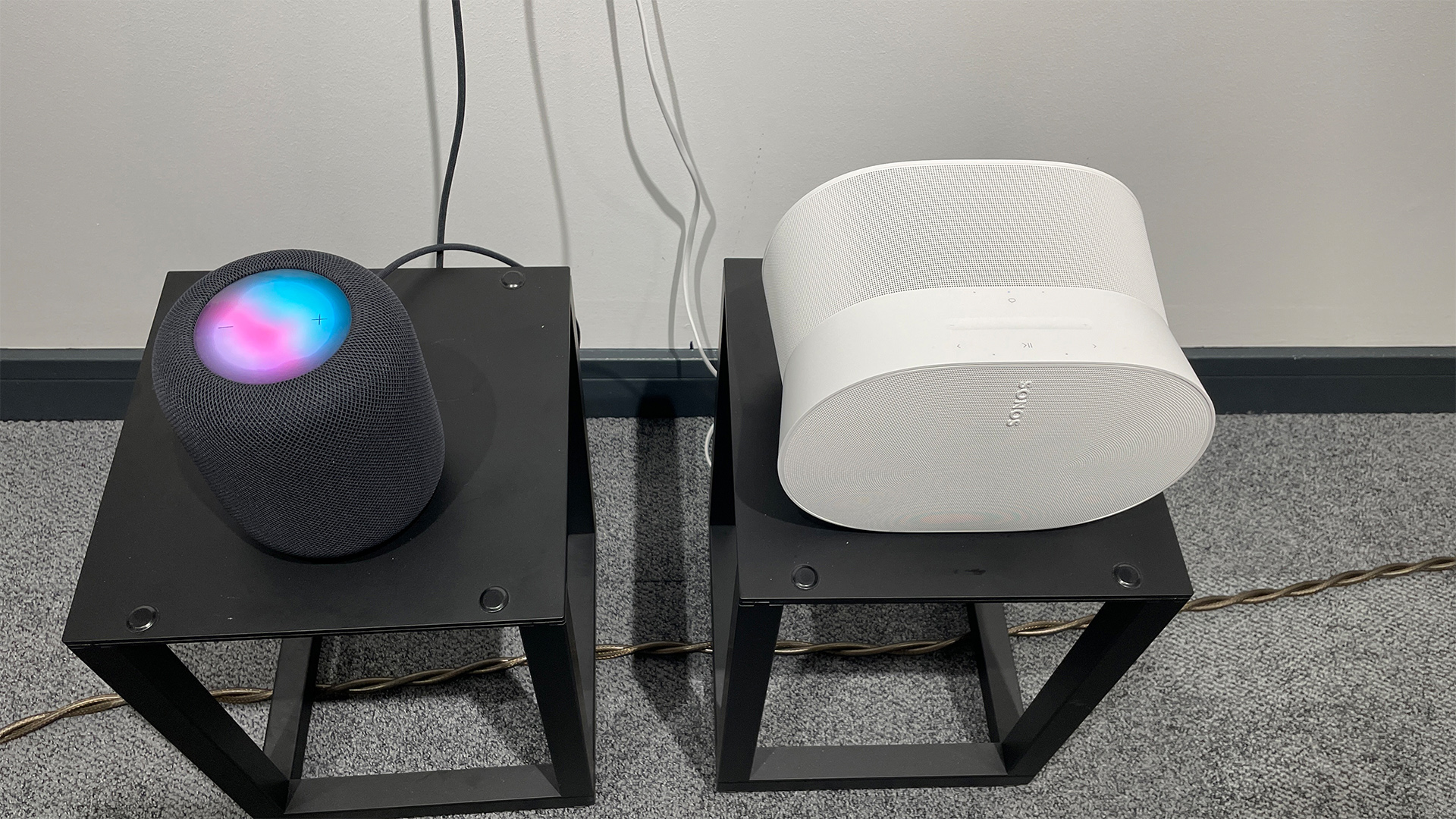
The Era 300 may have sounded a bit like a gimmick when first unveiled, but it’s a bold move from the company that feels fresh, innovative and confident. Does it convince us that spatial audio will overtake stereo sound? Not quite, but it’s the first time we’ve felt the two formats could be on a similar footing.
Sonos’s mission to deliver a great spatial audio experience from a single wireless speaker is a success, but that metric alone isn’t what makes the Sonos Era 300 an all-round enjoyable speaker. It performs admirably with any format of music you throw at it, no matter what source or genre. The addition of Bluetooth streaming, not to mention the vast array of features you get from being part of Sonos’s seamless experience, goes a long way toward justifying the rather high price tag attached to it. It all adds up to an enticing experience that’s worth embarking on.
SCORES
- Sound 5
- Features 5
- Build 5
MORE:
Read our review of the Apple HomePod 2
Sonos Era 300 vs Apple HomePod 2: which smart speaker is better?
Which Sonos speaker should you buy in 2023?
These are the best wireless speakers you can buy
Want a cheaper smart speaker? Read our Sonos Era 100 review







